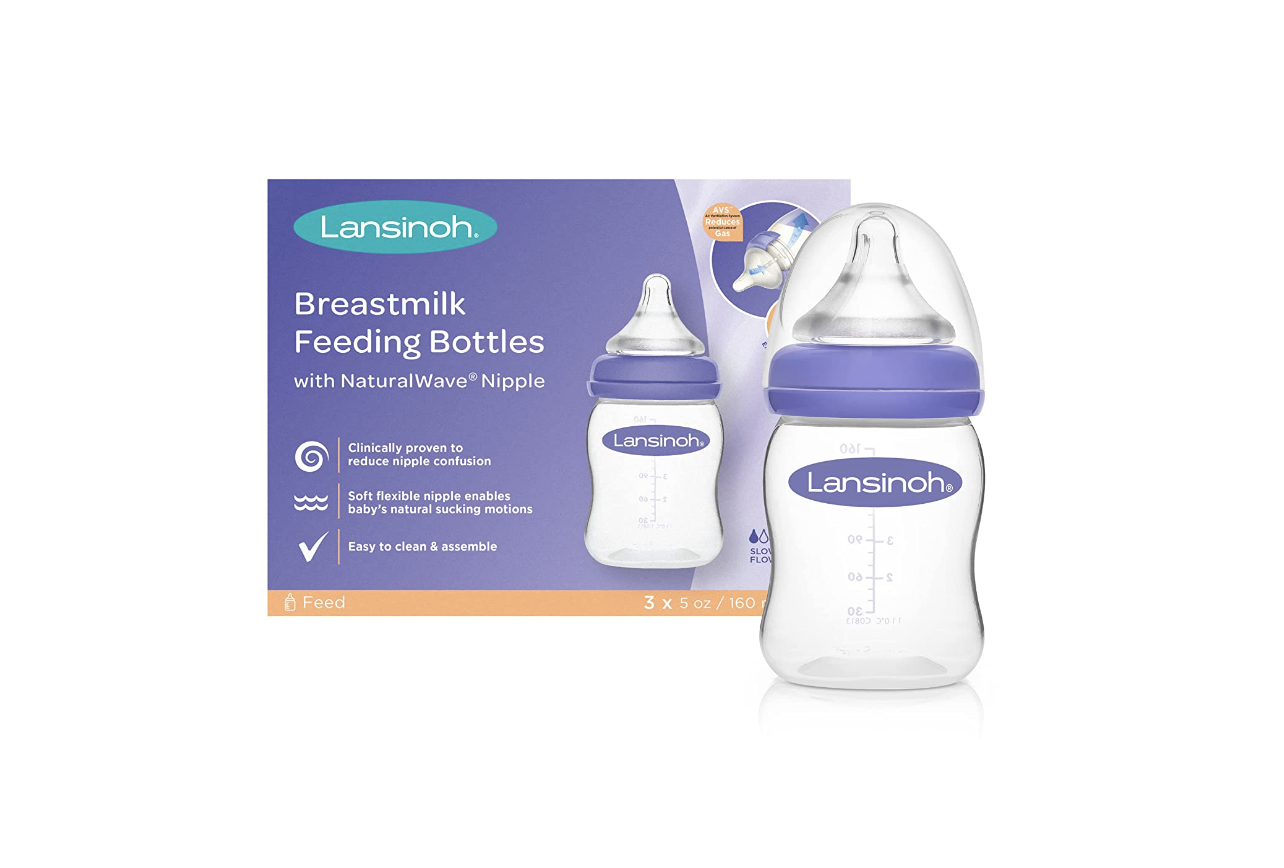The good news is, you’ve got options. But before investing a ton of money into a beloved brand or the bottle your BFF swears by for her boob babe, Lactation Education Counselor, Nannie Reinert of Dream Baby Lactation encourages parents to purchase several single bottles—that meet the below criteria—and see which one your baby prefers first. “Then you can easily order more based on what they like!”
- A soft nipple with a wide shape: “This type of nipple is closest to the breast and will allow your baby to get a deep latch and sucking motion similar to breastfeeding,” says Reinert. It should also help make the transition from boob to bottle (and back) less confusing.
- A slow flow: You want baby to have to work for the milk similar to how they would at the breast. You also don’t want the flow to overwhelm them and come out too fast. “Keep in mind that each brand’s slow flow nipple works differently, releasing a different amount of milk,” notes Reinert. “One brand’s slow-flow nipple might be fine, whereas another brand’s puts out too much milk at once, making your baby pull away and gasp, which can give him baby gas.”
- Easy to clean and assemble: Choose a bottle that you feel confident that you can easily put together and clean, advises Reinert. “Some bottles are more complex than others. Knowing you can easily throw one together in the middle of the night and can clean and sanitize without too much trouble is important too!”
Why breastfed babies are so fussy about bottles and nipples
We’ve all heard horror stories of breastfed babies completely refusing the bottle and this could be for any number of reasons—from a nipple flow that’s too fast to a nipple preference (ahem, yours).
“Babies also have a heightened sense of smell and taste and previously frozen milk can sometimes taste off to them,” notes Reinert. She recommends trying fresh milk—and experimenting with different types of bottles and nipples—to see what works best. “Sometimes babies don’t like to be bottle fed by the same person who breastfeeds them either,” she explains.
“If possible, try having another caretaker give your baby the bottle while you pump in the other room as far away as possible.” Some moms may even want to leave the house for a little with a manual breast pump and some yummy lactation cookies in tow.
When and how to introduce a bottle to a breastfed baby
Around three to six weeks of age when their latch is clearly established. Make sure baby is sleepy, calm and not hangry on that first try.
“It’s hard enough for adults to learn new things when we are hungry,” points out Reinert. “Have the person bottle feeding express a little breast milk to the outer nipple of the bottle so baby can use their amazing sense of smell to entice them. From there you want to use paced bottle feeding, where baby takes a few sips and then you pull the bottle away for a rest, to mimic breastfeeding as closely as possible,” she says.
The best bottles for breastfed babies
Best overall
Lansinoh Baby Bottles for Breastfeeding Babies
 Merchant
Merchant
Clinically proven to reduce nipple confusion (a big worry for breastfeeding mamas), this bestselling wide-necked bottle from Lansinoh has over 15k rave reviews on Amazon and a super impressive 4.7-average star rating.
The soft silicone NaturalWave nipple gives your babe the best boob-like experience by allowing them to use the same natural sucking pattern they would at the breast, making it the perfect option for paced feeds—and even the pickiest little ones.
Other features to love are the air ventilation system, which is designed to prevent your baby from taking in too much air as they drink and may help with gas, colic and spit up. The bottle is BPA and BPS-free so you know it’s safe and can be put in the dishwasher for quick cleaning.
Pros
- Clinically proven to reduce nipple confusion in babies
- Air ventilation system to keep baby comfortable and gas + colic-free
- Soft, flexible nipple with a wide shape to mimic the boob
- Ideal for paced feeds and transitioning from the boob to the bottle and back
- BPA and BPS-free
- Dishwasher-safe
- Great value
Cons
- Some parents say milk flow is too fast for their newborns

 PARENTING TIPS
PARENTING TIPS PREGNANCY
PREGNANCY BABY CARE
BABY CARE TODDLERS
TODDLERS TEENS
TEENS HEALTH CARE
HEALTH CARE ACTIVITIES & CRAFTS
ACTIVITIES & CRAFTS

